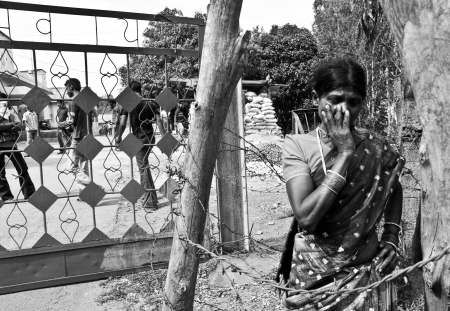The closer one gets to the eastern border of Gadchiroli district in Maharashtra, the closer one gets to the eerily similar narratives of violence and counter-violence. Maoist graffiti marks the asphalt, the walls, while police outposts find themselves marooned in the middle of nowhere, and the stories of brutal suppression, encounters, informant killings, and the threat of violence gets onerously louder.
This article appears in The New Indian Express on the 3rd of October, 2010.
 The Road To Abhujmarh.
The Road To Abhujmarh.
‘Nobody can even move anywhere. There’s too much risk.’ Says Superintendent of Police Veeresh Prabhu about the policemen posted at Laheri and Bhamragad police stations, closest to Maoist ‘liberated-zone’ Abhujmarh in Bastar.
‘I asked them why they were beating my son, and they beat me too.’ Said Dama Pada of the village of Mungner. ‘They told me that I was feeding Naxalites, and they beat me.’ Said the village-head of Mungner village.
‘The girl wanted to, but we believe that the family was too afraid to pursue the matter.’ Said a civil rights activist about a 13 year-old girl who was allegedly raped by a member of the elite C-60 group of Maharashtra.
‘As much as I have seen, the people are more afraid of the police than of the Naxalites.’ Said deputy collector of Gadchiroli, Rajendra Kanphade. On the 24th of August, he, along with eight members of the government visited the village of Binagonda in Naxalite-territory to look into the condition of the government-run Ashram schools.
The Fallout

Security forces on patrol on the Gadchiroli – Dhanora Road on the 1st of September, 2010.
Five security personnel were killed on the 31st of August, 2010 in Kanker district in Chhattisgarh. Two days later, in the neighbouring district of Gadchiroli in Maharashtra, security personnel are on a patrol on Dhanora road. Anti-landmine vehicles, and groups of 4-5 CRPF personnel and state police are positioned 30-40 metres along the Gadchiroli-Dhanora road. Just a few kilometres through the jungle is Kanker, where search operations are taking place.
‘Gadchiroli is Bastar’ isn’t something that far-fetched and one barely finds ears who disagree with it. The district of Gadchiroli in Maharashtra State, borders Rajnangoan, Bijapur, Narainpur District, Kanker district of Chhattisgarh, and more specifically, Abhujmarh, the infamous Maoist-bastion.
The river Indravati forms the border through Bijapur and Gadchiroli, yet the districts and their forests intersect near Bhamragad or Laheri police station in the north, and there is no surprise that here the police live in virtual prisons – no one dares to venture out too far alone.
Nearby, three young men cross the Indravati river in a dugout boat from Chhattisgarh to enter Gadchiroli. There is a clear organic link between Bastar and Gadchiroli. The Madia Gonds of Gadchiroli are similar, yet differ from the Murias and Koyas of Bastar, often referring to the ‘Abhuj Murias’ or ‘Hill people’ of Abhujmarh as the ‘Bada Gonds’.
‘Did the Salwa Judum ever come to your village?’ I asked one of the boys who just came from Bastar. He is a Muria boy. He affirms that the Salwa Judum had come to his village. And they burnt their village down, and beat people. Yet then a forest department ward officer shows up. The boy says hello to him and leaves.
A few days earlier, a team of government representatives had crossed this same river. They were led by the Deputy Collector, Rajendra Kanphade, and they crossed into Abhujmarh after being detained by the police in Laheri.
They had gone into Naxalite territory on the 24th of August, Tuesday, to check on the condition of the Ashram schools in the village of Binagonda. And there were no news of them for the next eighteen hours, and numerous officials believed they had been kidnapped by the Maoists. Yet they reappeared on Wednesday evening the next day, unscathed – nobody had harassed them, but the police at Laheri who had detained them a day earlier and refused to offer them protection.
Deputy Collector Kanphade would then deliver a scathing report about the condition of the schools in Binagonda.
‘The situation of these schools is terrible, there are irregularities in the number of students and malnutrition is pervasive.’
‘We already have schools from the Zilla Parishad, why do we need schools from the Tribal Welfare department also?’ Said Mr. Kanphade.
‘Some people are taking advantage of poverty. This is all just a money-making racket.’
There were around a hundred or more villagers who came to meet the Deputy Collector, the Tehsildar and other members of the team at Binagonda and the officials even took cognizance of the relationship of the people with the Naxalites.
‘They (the Naxalites) come to these villages with guns. So the villagers do what they want. And here, they’re evening paying for food.’ Said Mr.Kanfade. ‘I have been to many areas, and here too, it seems that the people in these areas are far more afraid of the police than the Maoists.’
‘There is legalized violence committed by the state, and illegalized violence committed by the Maoists. I do not agree with the violence of any party, especially the Maoists, but I personally feel that the legalized violence of the state is far more destructive.’
A few days after Mr.Kanphade would make similar comments in the local and national press, the Superintendent of police Veeresh Prabhu would request the Collector’s office to initiate disciplinary measures against the Deputy Collector, for his statements have ‘maligned the image of the government’ and ‘affected the morale of the police.’
Commenting that some of the news reports had misquoted him, Mr.Kanphade, nevertheless stuck with his statements.
‘What have I done?’ Retorts Mr. Kanphade, ‘I have gone to a village and reported on the issues of the village. Instead of addressing the issues of the people, the police want to suffocate the truth.’
The village of Mungner
On the 31st of August, 2010, in the predominantly Madia Gond village of Mungner in Gadchiroli district, Maharashtra, four villagers were beaten by the security forces during a routine operation.
‘They came from all sides, and they asked all the villagers, men, women and children to come at one spot.’ Said Tukaram Walko, the village-head or ‘Patel’, who was caught returning from his fields with an empty steel box. ‘A policeman saw my empty box, and said I was feeding Naxalites and slapped me there and then.’
‘Then they told us not to support the Naxalites, and threatened us.’ Said another villager, ‘He (Hingle, the CO) said that I can kill ten of you just like this.’
Mungner is said to be around three kilometres from Chhattisgarh and unsurprisingly, the villagers are not shy to reveal that the Maoists do visit them. Three years ago, they had even killed the then village-head for being a ‘mukhbir’ or informant. At the same time, the villagers revealed that a ‘surrendered’ Maoist had brought the police to their village.
‘Don’t tell them.’ Screamed a woman from the hut, when asked about his/her identity. An animated discussion ensued in Gondi between the rest of the villagers thereafter.
‘There were bullets flying across our homes’
This was not the first time the police had come to Mungner – a village where the crops failed for lack of monsoons for the last two consecutive years, where there is one patta (title) for 180 homes, where contractors defaulted on NREGS payments, and the Forest Department had been cutting bamboo for Rs.1 over thirty years ago. Mungner is deep within the jungle but a dirt road does lead to it from Dhanora Police Station.
On the 6th of April 2009, an encounter had taken place near the village of Mungner, and three security personnel were killed, while the police claim over seven Maoists were also killed.
On that day, the villagers heard gunfire that lasted till evening, and claimed that gunfire had even gone over their roofs.
‘Us din duniya bhar ki gadiya gaon aa gaye the.’ (all the world’s cars had come to our village that day), Said Budram Galme, the Sarpanch of Mungner, referring to the police rescue party.
Yet irrespective of the proximity to the Maoist ambush, the villagers claimed no one was mistreated by the police in retaliation.
‘Munna Thakur (commander C-60) was good to us,’ said a villager, ‘whenever there was an incident of firing nearby, he used to tell us to stay away. And no one from our village was harassed.’
‘He may have been something else to other villages, but he was okay with us.’
The legend of Munna Singh Thakur.
Munna Singh Thakur is a name well-known in even adivasi villages in Gadchiroli district. The commander of the elite C-60, a specialist counterinsurgency group, Munna Singh Thakur lost his older brother Lalbabu Singh to an encounter with the Maoists on the 8th of July, 1988.
‘He was shot seventeen times, I still remember that day,’ Said Munna Singh Thakur, who was 18 at the time, ‘He was left alone to fight. The other policemen had all run away. And even now those policemen are still in the service.’
Munna Singh Thakur would then serve in anti-naxal operations in Maharashtra for the next 21-22 years. There are many observers who even believed that the C-60 under Munna Singh Thakur worked without the authority of the then S.P Rajesh Pradhan, but worked directly under the auspices of the Director General of Police (Anti-Naxal Operations) Pankaj Gupta. Munna Singh Thakur functioned out of Pendri police station, effectively given a free hand since around 2004.
The immediate villages around, would grow to fear him and his reputation, or in the particular case of Mungner, find him reasonable – making him a proponent of a carrot-and-stick, counterinsurgency.
Nevertheless, 2009 was a particularly brutal year for the police. There were three highly reported incidents where the security forces were ambushed, often with deadly results. 15 police officials including a sub-inspector were killed on the 1st of February near Markegaon, 16 police officials, including five women personnel were killed on the 17th of May, and 18 were killed near Laheri police station on the 8th of October during the assembly elections. Munna Singh Thakur was the CO when his party was ambushed near Mungner village where they only suffered three casualties. And 2009, has now ensured that no police party can move within the sensitive areas of Gadchiroli in smaller numbers.
In that year alone, there were a total of 52 fatalities from the police, in contrast to a total of 27 fatalities amongst the police in the four years preceding 2009. In 2009, Gadchiroli district was elevated to being one of the worst-affected LWE (left-wing extremism) districts. In 2010, there have been minimal incidents of violence, with only two fatalities amongst the police as of September the 13th. Interestingly, all three, Munna Singh Thakur, Pankaj Gupta and the then SP Rajesh Pradhan, were transferred out in 2009 itself.
‘The police had not followed basic standard operating procedures in 2009, they kept going out in small numbers and made mistakes. The incidents were self-created.’ Said a local journalist in Gadchiroli, ‘Munna Thakur with his signature of carrying two rifles, was useful, quite dynamic, if he was told to rescue one police party, even as he is engaged in another area, he would.’
‘A particular incident took place where a police party was stranded in the jungle, and their commanding officer was too circumspect to move, believing they’d be ambushed if they did. Munna Thakur, dutifully, would be sent to rescue the party. And yes, mission accomplished. No casualties.’
‘There were many incidents like this where I was involved,’ Said Munna Singh Thakur, now posted in Nagpur, ‘I once had to rescue a jawaan who lost his hand at 12 in the night.’
‘But I got tired of all of it.’ He says, ‘I had to take note of my family, my children are older now and the risks I took, affected them. I have been wounded, my jawaans were killed.’
‘I got tired.’
The village of Paverval
Advocate Anil Kale, of the Indian Association of Peoples Lawyers was sent a message through the Jailer of Chandrapur jail, by one of his clients in jail. The message was about a young girl who had just arrived in prison. In violation of the Juvenile Justice Act, a child who was proved to have been born on the 20th of March, 1996, was sent to prison after being arrested by the police in the village of Paverval on the 4th of March, 2009. She was just shy of her thirteenth birthday.
‘My client had also told me that the girl claimed she was raped by the police.’ Said Advocate Kale.
The girl would eventually be released on bail after she was produced before the Juvenile Justice Board. She had been booked under sections 307 (attempt to murder), 143, 147, 148, 149 of IPC and section 3, 25 of the Arms Act.
Payal (name changed) had been visiting her sister in the village of Paverval when the police had raided the village on the 4th of March, 2009. An unidentified man had run past her sister’s home at the edge of the village as the police gave chase. Gunshots were heard, and the police returned to the house without the man, and started to beat villagers, including Payal’s brother-in-law Kaju Potawe insinuating that they were helping the ‘Naxalites.’
The police would spend the night in Paverval village, with eight villagers, including Payal detained in the home of Dayaram Jangi. At some time in the morning, Payal was raped repeatedly. One of her alleged rapists was none other than Munna Singh Thakur.
Eventually, all of them were flown out by helicopter.
‘She gave us graphic details, these were not things a thirteen year old should know.’ Said a civil rights activist from the Committee Against Violence on Women who was involved in the fact-finding team that would take Payal to the police and register her complaint.
‘Payal did not use the word rape.’ Mentions the fact-finding report, ‘She used the word “badmash kaam”. Payal said that her breasts and her entire body were pressed. Then, that portion of the male body from which urine is passed was pushed into that part of her body from which she urinates. The first person who raped her told her that he was Munna Singh Thakur, and that she must have heard of him. Payal said that she was in great pain, and after sometime she fainted. She gained consciousness when the police were splashing water on her.’
‘The investigation into the rape was initially lukewarm,’ Said Advocate Kale, ‘We even took the girl and the family to meet the Superintendent of Police, but he stuck with his man. Eventually, they had an inquiry and he was transferred.’
‘At night, the DSP had asked us about where we’d be sleeping. They knew we’d be sleeping at the guest house. And over there, the girl identified Munna Thakur, loitering around the guest house.’
‘All those allegations are just the work of Naxals.’ Said Munna Singh Thakur in Nagpur, ‘There were 60-70 of us there, and we encountered that girl, and put her on a helicopter and took her. Nothing else.’
Yet that is not the only cause of anger against Munna Singh Thakur.
‘Munna Singh Thakur should be hanged.’ Says Manik Jangi of Paverval village. His own son Ramse Jangi was shot dead by a police-party lead by Munna Singh Thakur in 2006, and at the same time, another son is the only one in the village who has studied past his 11th grade.
Post-Script

A memorial room for policeman slain in Naxal-related violence in Gadchiroli police station. The earliest dated portrait was of Lalbabu Singh of the State Reserve Police Force who was killed in 1988.
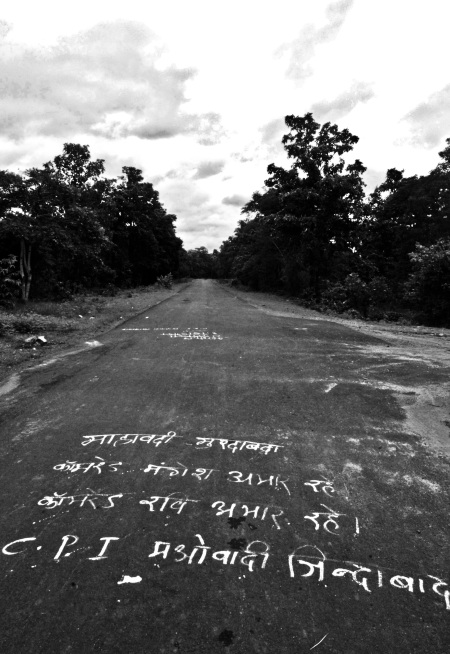
Maoist grafitti on the road to Bhamragad commemorates two fallen Maoists, Mangesh and Ravi.

Mixed Fortunes: Manik Jhangi of Paverval village, Gadchiroli district, lost one son to the police in 2006. Another son is the first boy in his village who has passed his 10th standard.
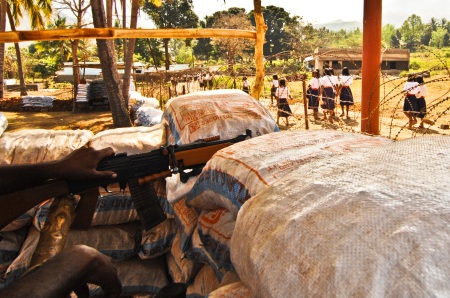
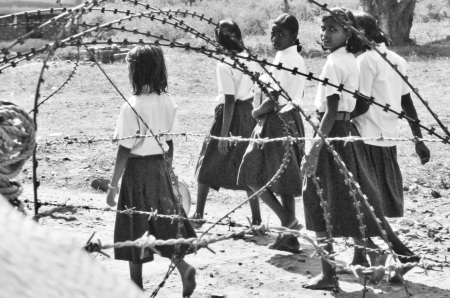

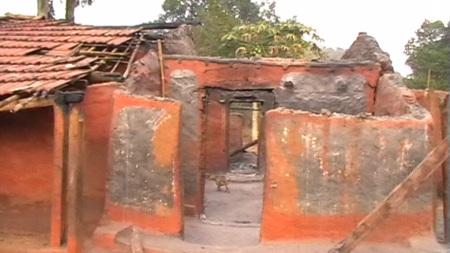
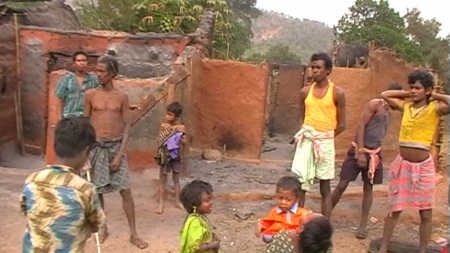



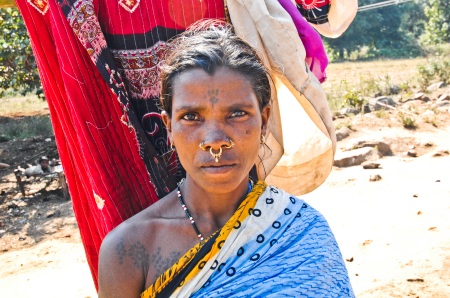

 The Road To Abhujmarh.
The Road To Abhujmarh.






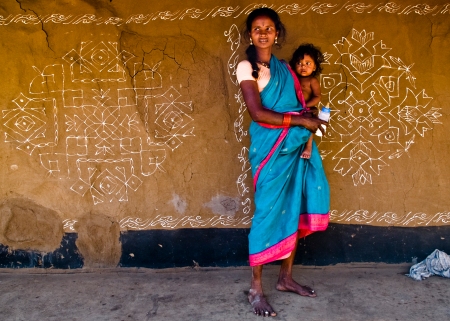

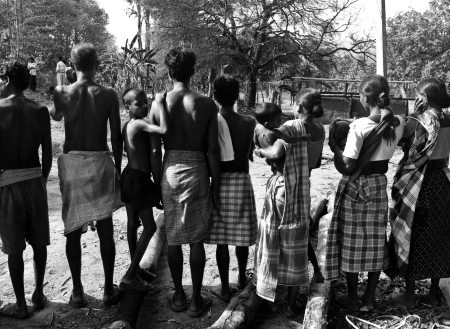
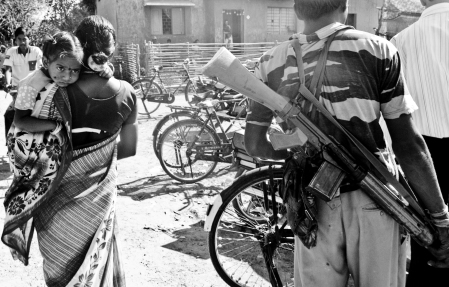
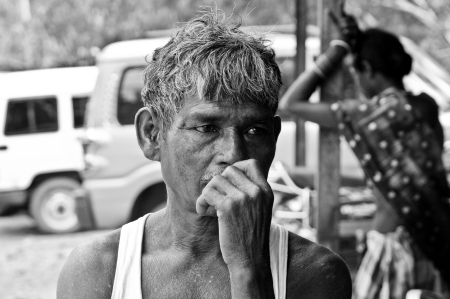
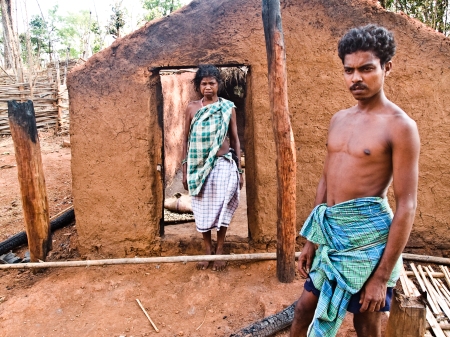
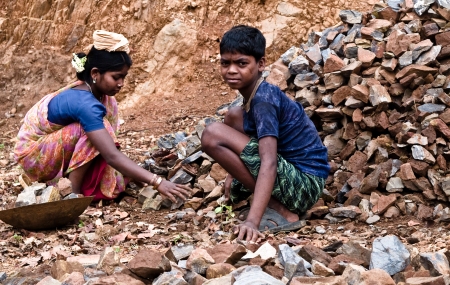 Young labour at work on a road in Dantewada, 2009.
Young labour at work on a road in Dantewada, 2009.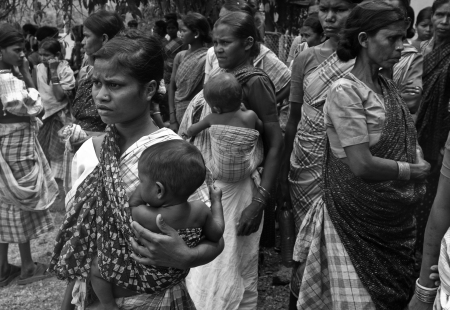 The villagers of Hiroli waiting outside Kirandul police station for the body of Channu Mandavi who was killed in an encounter on the 12th of April, 2009.
The villagers of Hiroli waiting outside Kirandul police station for the body of Channu Mandavi who was killed in an encounter on the 12th of April, 2009.